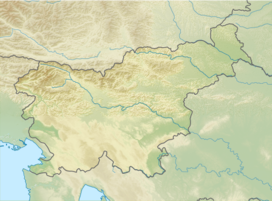Trnovo Forest Plateau
| Trnovo Forest Plateau | |
|---|---|

The Trnovo Forest Plateau seen from Vipavski Križ
|
|
| Highest point | |
| Coordinates | 45°57′46″N 13°52′20″E / 45.96278°N 13.87222°ECoordinates: 45°57′46″N 13°52′20″E / 45.96278°N 13.87222°E |
| Geography | |
| Location | Slovenia |
| Parent range | Dinaric Alps |
The Trnovo Forest Plateau (Slovene: Trnovski gozd) is a karst plateau that constitutes the extreme northwest end of the Dinaric Alps. The Trnovo Forest Plateau has a karst character, without surface watercourses and broken up by closed valleys, outcroppings, hills, caves, shafts, and smaller karst features: solution pans, rills, karrens, and other features. Significant karst features include ice caves. The vegetation inversion at Big Paradana Ice Cave (Slovene: Velika ledena jama v Paradani) in the eastern part of the plateau, measuring 385 meters (1,263 ft) by 1,550 meters (5,090 ft), is a locus classicus and in the past ice was harvested from it and exported via Gorizia and Trieste to Egypt.
The Trnovo Forest Plateau has three nature reserves:
The influence of tectonic activity is very evident in the area. There are many depressions, solution valleys, small karst poljes, and the remains of former river valleys. During the Pliocene the rivers leveled the tectonic upwelling and filled the valleys. Traces were also left by Pliocene glaciation because glaciers created small cirques on what had been a relatively level surface, as well as ground moraines and terminal moraines. The rivers transported gravel and deposited it in lower areas, filling the depressions.
The north side of the plateau shows tectonic formation along the Idrija Fault oriented in the Dinaric direction, and the south side shows the results of tectonic thrusting of Mesozoic limestone and dolomite over younger Eocene flysch. Two-thirds of the surface is covered by limestone, one-fourth by dolomite, and the remainder is flysch and loose material.
The climate of the Trnovo Forest Plateau is defined by its elevation and orientation. The Trnovo Forest Plateau lies in a continental temperature zone. It receives an average of 1,881 millimeters (74.1 in) of precipitation per year. Differences in the quantity of precipitation differ little on a monthly basis. The greatest precipitation is in November (293 millimeters or 11.5 inches) and the least in February (135 millimeters or 5.3 inches). The majority of winter precipitation is in the form of snow, especially at higher elevations. The bora wind is a typical weather phenomenon, blowing down from the plateau towards the sea with gusts often exceeding 100 kilometers per hour (62 mph). The bora can cause considerable damage in the area, uprooting trees and tearing the roofs off of houses.
...
Wikipedia

